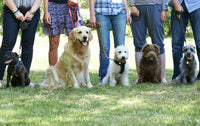Subtotal
CAD $0.00
or
I remember years ago when certain celebrities made Chihuahuas a must have accessory. They were everywhere!
They were so cute and little, they were carried in purses or designer dog bags. They had the blinged out collars, painted nails, and all kinds of glitz that went with being a living accessory.
But, then there was the fallout of people getting them, not realizing the commitment, and giving them up. There was a lot of media coverage surrounding this, and things have quieted a bit. However, designer dogs are booming again, with specific crossbreeds being sought after. Did we learn our lesson?
The term “designer breed” or “designer dog” refers to a dog that is a crossbreed of 2 purebred dogs that has been bred for a specific reason. One of the original purposes of this specific trend came with the crossbreeding of hypoallergenic dogs with dogs that had a look people wanted.
An example of a current popular breed right now is the Cockapoo, which is a mix between a cocker spaniel and poodle. This also illustrates how the new breed is named, with a fun mix of the original breeds.
Designer dogs aren't just for looks, which makes the industry a little more stable than the Chihuahua trend. In fact, the designer dog isn't a new concept, we've just renamed it for the recent fad. Dogs have been bred for centuries to highlight certain traits, but the traits have changed.
Before, society focused on strength, smell, obedience, stamina, and guard instincts, and any other traits to help a working dog. Now, we focus on mostly how cute a dog can be made. Of course, temperament and things like being hypoallergenic do come into play.
So what does the actual industry look like? Well, like anything, you're going to have good and bad places to do business with. Responsible breeders need to know their animals, have experience, and truly want the best for their dogs. They should understand which breeds wouldn't mesh well, as well as have their dogs tested for genetic disorders specifically affecting hips and eyes. Basically, they should be treated as purebreds with papers documenting their genetics and parents.
However, this also opens the doors for people to make quick cash selling pups that may not have the best breeding or genetics. You could make a cute puppy, but if you cross a short snouted dog with a hunting dog, you can run into respiratory problems. Those out to make fast cash don't care about these things and these dogs end up in shelters, and there's a lot of cash to be had.
In 2014, the latest year data was found, the industry had reached 60 billion dollars worldwide. Designer dogs often fetch more than their purebred parents, up to 50% more. The most popular breed in 2014 was the morkie, which fetched a price up to $2,000 per animal. And with designer dogs comes pricey clothes, accessories, boarding and training services, grooming, and food, causing a boom in the market overall.
Designer dogs can make for some amazing pets, but don’t get caught up on how cute they are and go buy one. Like any animal, they take dedication, time, and money. Designer dogs may also require more care simply because of their breeding. If at a loss of where to go, a good route would be for a referral from a veterinarian and make sure to do research on red flags that may indicate a puppy mill.




